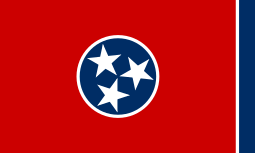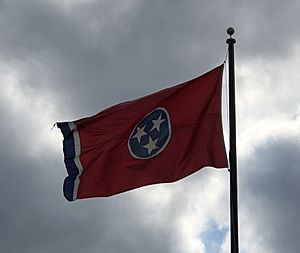Flag of Tennessee facts for kids
 |
|
| Name | The Tri-Star Flag |
|---|---|
| Use | Civil and state flag |
| Proportion | 3:5 |
| Adopted | April 17, 1905 |
| Design | A blue circle with three white five-pointed stars on a rectangular field of red, with a strip of white and blue on the fly. |
| Designed by | Col. Le Roy Reeves |
The flag of Tennessee is a special symbol for the state. It has a red background with a blue circle in the middle. Inside the circle are three white stars. On the right side of the flag, there's a blue stripe with thin white lines next to it.
This flag's design, especially the part with the stars, is often used as an unofficial symbol for Tennessee. You might see it in the logos of companies or sports teams from the state, like First Horizon Bank or the Tennessee Titans.
In 2001, a group called the North American Vexillological Association asked its members to rank the flags of U.S. states, territories, and Canadian provinces. The Tennessee flag was ranked 14th out of 72 flags.
Contents
History of the Tennessee Flag
Before the American Civil War began in 1861, people in Tennessee thought about creating a state flag.
Later, in 1897, Tennessee adopted a different flag. It had three slanted stripes of red, white, and blue. These slanted stripes were meant to show the three different geographical areas of Tennessee. That flag also had the number "16" on it, because Tennessee was the 16th state to join the Union. It also said "The Volunteer State," which is Tennessee's official nickname.
The flag we see today was designed by Colonel Le Roy Reeves. He was a lawyer from Johnson City and served in the Tennessee National Guard. The state government, called the Tennessee General Assembly, officially chose this flag on April 17, 1905.
What the Tennessee Flag Looks Like
What the Symbols Mean

The three stars on the flag stand for the three main regions of Tennessee. These regions are East, Middle, and West Tennessee. The blue circle around the stars shows that these three regions are united and work together.
The blue stripe on the right side of the flag was added for design reasons. Colonel Reeves said it helps the flag look better and prevents too much red from showing when the flag hangs down. In 1917, a magazine called National Geographic mistakenly said the stars meant Tennessee was the third state to join the Union after the first thirteen colonies. This was incorrect.
Some experts have noticed that the Tennessee flag has some visual similarities to flags used by the Confederacy. For example, both use white stars inside a blue shape on a red background. However, there is no direct proof that the Tennessee flag was designed to copy the Confederate flag.
How the Stars Are Placed
There are specific rules about how the three stars must be placed on the flag. State law says that the stars should not line up perfectly straight across or up and down. Instead, they should be a bit angled. The star that is highest up should be the one closest to the top corner of the flag.
In 1976, the U.S. Postal Service printed stamps with U.S. state flags. The Tennessee flag on their stamp was accidentally printed upside down!
Other Tennessee Government Flags
Besides the main state flag, the government of Tennessee uses other flags too. The flag for the governor of Tennessee has been used since 1939. It's a red flag with four stars, one in each corner. In the middle, it has the state's military symbol, which is a tree with three white stars. The Tennessee General Assembly, which is the state's law-making body, also has its own flag.
Gallery
See also
 In Spanish: Bandera de Tennessee para niños
In Spanish: Bandera de Tennessee para niños





